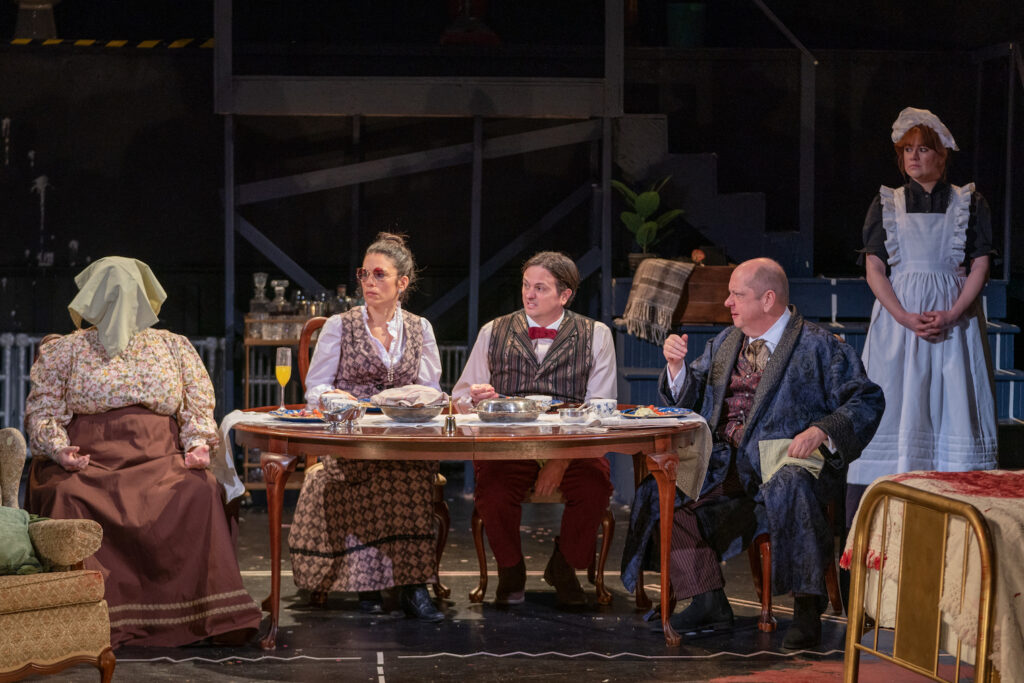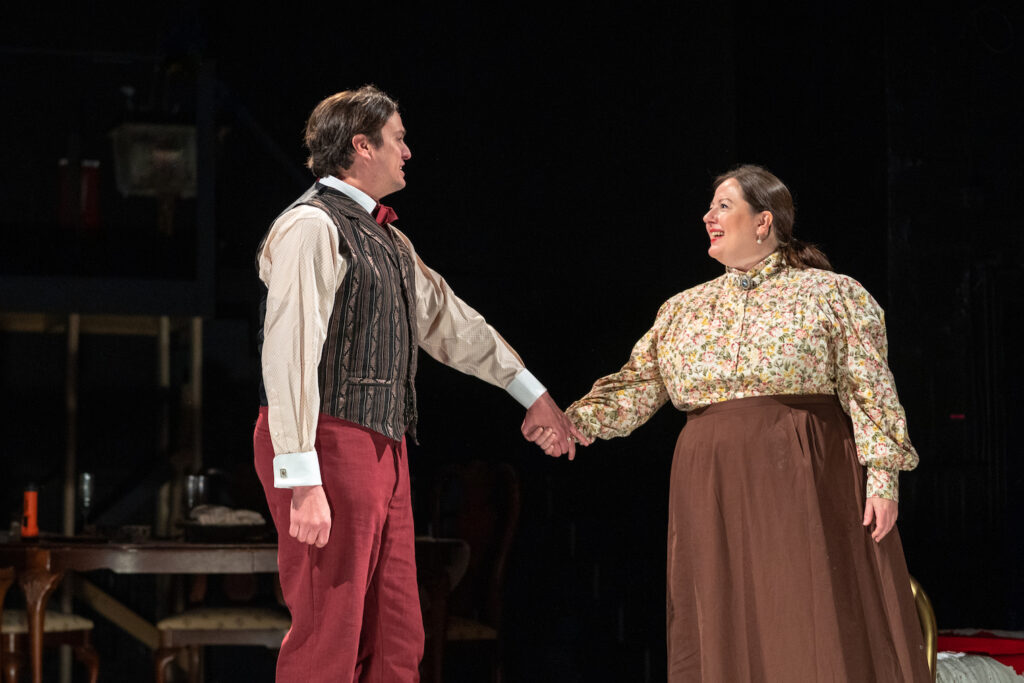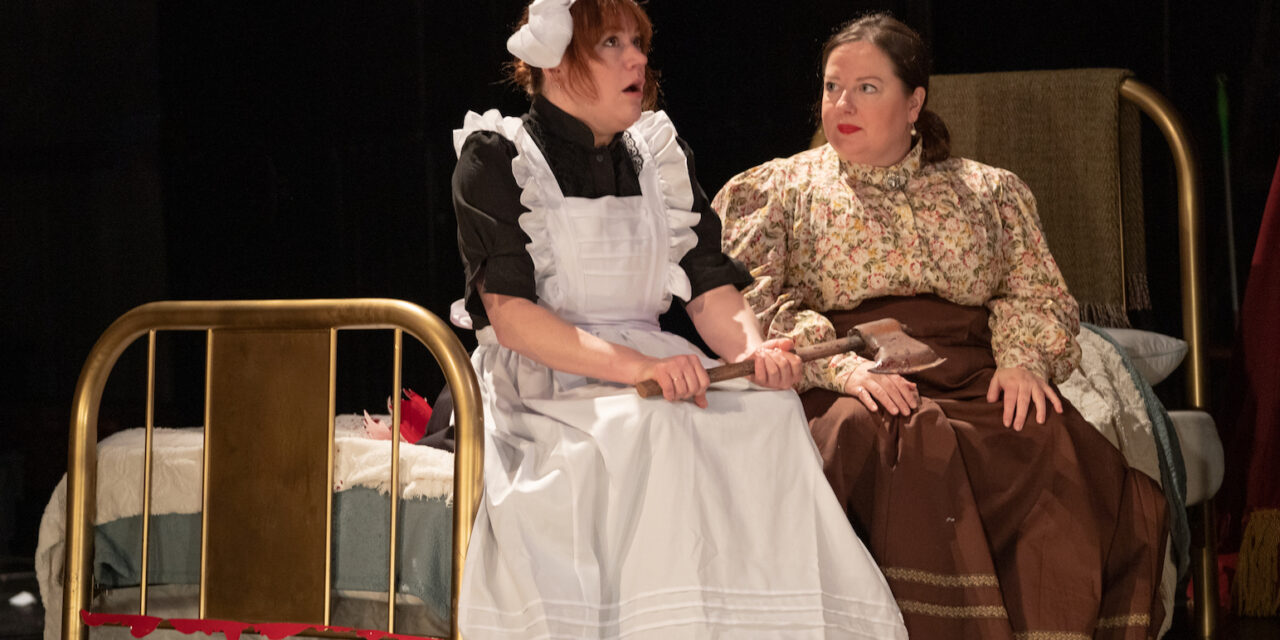By Walter Murphy . . .
Upon entering the theater for Bedlam’s Fall River Fishing, the stage is set, literally, for a performance that will be different. Anyone with rudimentary familiarity with the infamous Lizzie Borden story can view the stage—complete with a blood-splattered couch and bed—and assume to know how the performance will play out. This being a Bedlam production—directed by its unique artistic director Eric Tucker—however, surprises abound.
Bedlam’s mission is to “reinvigorate traditional forms.” In this production—written by Zuzanna Szadkowski and Deb Knox, who both star in the play—they certainly deliver on that promise. The “forms” are the real-life Lizzie Borden murders (Act I) and Ibsen’s The Dollhouse (Act II). Although each act refers to an earlier century, most theater-goers are familiar with the subjects, and consistent threads emerge. The act of murder is gruesome, and can be “justified.” The living share the experience of being defined by the dead, as told by the characters in the play, “Baby, we’re so often defined by the people who aren’t here anymore. We’re made of absence.” The play refers to others, gone but not forgotten: Sharon Tate, Eva Braun, and John Belushi. Hitler even makes a cameo.

Expect the Unexpected.
In Act I, the Borden household presents as dysfunctional in the extreme: Bad, boorish behavior, physical, emotional and verbal violence from Ma and Pa Borden (Susannah Millonzi and Tony Torn, respectively). It’s almost as if the point is to justify the murders, which we already know will happen because the pre-bloodied Victorian-esque set (Cate McCrea) tells us so. So, naturally, it’s not terribly shocking when the hatchet is swung.
The production departs from the traditional by time-traveling between the “past” (the actual murders took place in 1892) and today by injecting current cultural references—like Nathan (an amusing Jamie Smithson) discussing his preference for eating Greek yogurt for breakfast. The play presents a chronological idea of things happening simultaneously across a spectrum of time—that everything changes (over these 100 plus years), yet remains the same. When Lizzie (Zuzanna Szadkowski) and the maid, Bridget (Deb Knox) agree that they are “together” as a couple (their relatively open lesbian relationship being another cultural anachronism) they immediately conclude “We’re together. Let’s hide it.”


In Act II, the setting shifts to Norway (of course! . . . ?) and there marital discord ensues, following The Dollhouse alignment—two of the main characters are called Torvaldt and Nora, who almost appear to be in hiding, as if anyone in Oslo wouldn’t get the reference. Characters from the previous act change personas but the idea that murder brings people together remains. One character admits that he was accused of murdering his family (two children and his wife). With a nod and wink he slyly announces, à la Gomez Addams— “Acquitted!” Then a bloodied, pregnant Sharon Tate “ghost” in a negligee appears, and although she frequently mentions her ”Roman” (Polanski, no doubt), she may also be another character’s mother. Again, expect the unexpected. What you see and hear on stage may or may not be the play’s reality.
The production features drama and laughs throughout. Not surprising, given the subjects of murder, unhappiness and unrequited love most easily give way to dark humor. There are quips and asides throughout that break not only the tension, but the absurdist confusion that falls across the audience at regular intervals. But what may be the high point of the festivities is a food fight towards the end of the play. Why not end with a food fight? And yes, totally unexpected and appreciated by the audience.


So, as the mission of Bedlam is to use traditional forms and then change expectations, the theater experience becomes everything that happens during the production. I point this out because, at the production I attended, toward the end of a seemingly longish intermission, the stage director came to out to apologize for the delay. He explained that there was a potential fire hazard in the theater that had to be investigated and cleared, which it was. Prior to the announcement, a fireman in full gear was seen walking near the seats. Was that a genuine, potential hazard or one of the many surprises designed by Bedlam? Was it part of the play? Either way, it was certainly unexpected . . . which was what had become expectation from this theater experience.
Fall River Fishing. Through March 9 at the Connelly Theater (220 East 4th Street, between Avenue A & B). www.bedlam.org
Photos: Ashley Garrett
Cover Photo: Deb Knox and Zuzanna Szadkowski


















